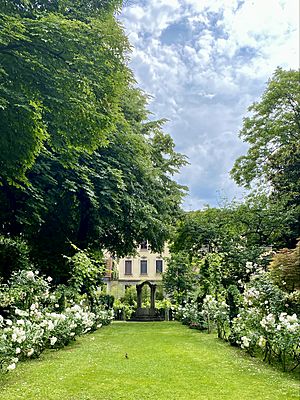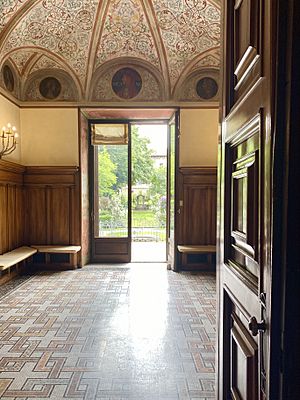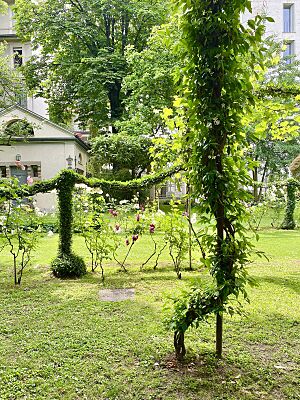Leonardo da Vinci's Vineyard facts for kids
Leonardo da Vinci’s Vineyard is a special vineyard that the Duke of Milan, Ludovico Sforza (also known as Ludovico il Moro), gave as a gift to Leonardo da Vinci. This happened in 1498 while Leonardo was busy painting The Last Supper nearby. The Duke gave Leonardo this vineyard to thank him for all the amazing artworks he had created.
Leonardo's Special Vineyard
This vineyard was located in Milan, a city in Italy. It was in an area called Porta Vercellina, very close to the Borgo delle Grazie, which was part of a much larger vineyard.
The Duke planned to give Leonardo a vineyard with 16 rows of grapevines. Leonardo himself wrote notes about the size of this land in his famous notebooks, the Codex Atlanticus and the Manuscript I of France. He noted it was about 59 meters (64 yards) long and 175 meters (321 yards) wide. This means it was about 1 hectare (2.5 acres) in total.
In 1920, an Italian architect named Luca Beltrami used old documents to figure out where the vineyard probably was. He believed it ran next to what is now Via De Grassi street. He even took photos of the vineyard area before it was divided up for new buildings.
A Story Almost Forgotten
The vineyard is first mentioned in an official paper from October 2, 1498. However, Duke Ludovico Sforza's gift was fully confirmed later, in a letter dated April 26, 1499.
Soon after, wars broke out in Italy, and the French army took over Milan. This forced Duke Ludovico Sforza to leave, and Leonardo also left the city. Before he left, Leonardo rented his vineyard to Sir Pietro di Giovanni da Oppreno, who was the father of Leonardo's helper, Gian Giacomo Caprotti (also known as Sir Salai).
When the French took control, they looked at all the gifts Ludovico Sforza had made. In 1502, they took the vineyard from Leonardo and gave it to a different official. But in 1507, Charles d’Amboise, who was King Louis XII's representative, asked Leonardo to come back to Milan. Leonardo was living in Florence at the time. When he returned, Leonardo explained that his vineyard had been taken.
Because of this, the vineyard was given back to him. An official decision said that Leonardo should not have to pay "even one penny" for it.
Dear Sirs. Regarding the case of Sir Leonardo from Florence we ask you to return him his Vineyard without any charge of expenses from his part.
(Italian: Dilecti nostri. Tocando il caso de magistro Lionardo fiorentino ve dicemo et commettemo che lo remettiate nel primo stato, come esso era, de la vigna sua inante che la gli fusse tolta per la Camera, et non gli fareti chel ne habia a patire spesa pur de uno soldo.)
Leonardo stayed in Milan until 1513. Then he went to Rome and later to France, where he passed away. In his last will, written in France a month before he died, Leonardo decided that his rectangular vineyard should be split into two equal parts. One part went to Sir Salai, who had built his house there. The other part went to Giovanbattista Villani, a loyal servant who had followed Leonardo to France. This shows how much Leonardo remembered his vineyard even at the end of his life.
By this last will the undersigned is to grant in perpetuity his garden located just outside Milan’s city walls in part to his servant Batista de Vilanis and in part to his servant Salay, who had previously built there a house, which will be forever his and his successors’, and this is intended to be a token of appreciation for the services and assets, the above-mentioned Vilanis and Salay, had provided him with.
(Italian: Item epso Testatore dona et concede a sempre mai perpetuamente a Batista de Vilanis suo servitore la metà zoè medietà de uno iardino che ha fora a le mura de Milano, et l'altra metà de epso jardino ad Salay suo servitore, nel qual iardino il prefato Salay ha edificata et constructa una casa, la qual sarà e resterà similmente a sempremai perpetudine al dicto Salay, soi heredi et successori, et ciò in remuneratione di boni et grati servitii, che dicti de Vilanis et Salay dicti suoi servitori, lui hanno facto de qui inanzi.)
By 1534, Villani had given his part of the vineyard to the nearby San Gerolamo Monastery. The other part, which was closer to what is now Via Zenale street, was passed down to Sir Salai's family after he died in 1524.
Bringing the Vineyard Back to Life
Leonardo’s Vineyard was brought back to life for Expo 2015, a big world fair. This project was made possible by the Portaluppi Foundation and the owners of the nearby Atellani House. The President of Italy also supported it, and the University of Milan helped a lot.
In 2007, a team led by Professor Attilio Scienza, an expert in grape genetics, found living parts of the original grapevines in the Atellani House’s garden. They carefully dug them up and studied them. Their research helped them replant the exact type of grape that Leonardo had: Malvasia di Candia Aromatica. On September 12, 2018, the grapes from Leonardo’s Vineyard were harvested for the very first time in centuries!





